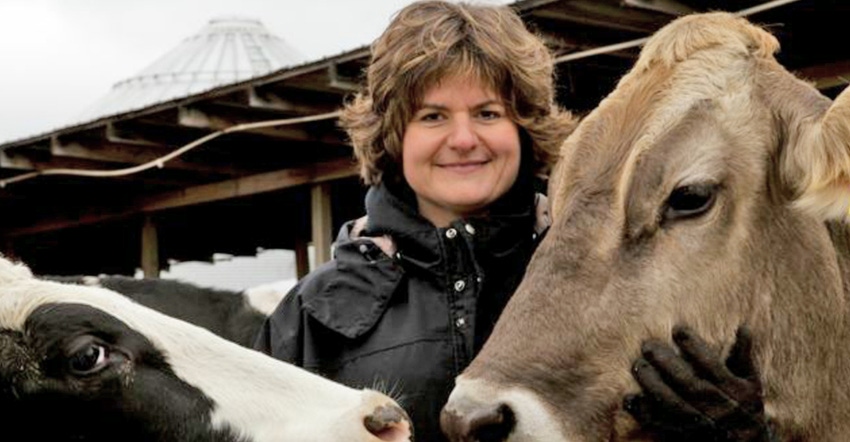
A lifelong dairy farmer, Sam Schwoeppe is on a mission to get as much milk as possible donated to Feeding America so people who are food-insecure can have more milk to drink.
Since May, Schwoeppe has been the regional dairy sourcer for Feeding America. She works with food banks throughout the country to increase their access to fresh milk and dairy products.
“I am trying to develop a new marketing channel for our dairy products and working to change the impression that food banks only receive donated food,” Schwoeppe explains. “They also purchase a large amount of food. Dairy has not been one of these foods; however, it is my job to change this and help develop a new market for dairy within the food banks.”
Lofty goals
“My goal is to see milk in every food bank and every food pantry, homeless shelter, and soup kitchen in the country,” Schwoeppe says.
Schwoeppe lives with her husband, Darren, and sons, Wyatt and Ethan, on a dairy farm in southwestern Indiana that has been in Darren’s family since the Civil War. They milk 105 cows and farm 260 owned and rented acres near Huntingburg.
“I grew up on a dairy farm, and I still live on one. I am very proud to be a part of American agriculture,” she says.
According to Feeding America, one in eight people, including one in six children, in this country are food-insecure.
“That includes rural areas, too,” Schwoeppe says.
Milk is one of the top three products requested by food bank clients, she says. But dairy comprises only 5.9% of all products received at food banks. Feeding America clients receive only 1 gallon of milk per person per year, while average consumption for Americans is 20.4 gallons per year.
“Clearly, they would drink a lot more milk if they could get it,” she says.
Schwoeppe says she understands what families who are food-insecure are going through. “My parents were foster parents,” she says. “We had more than 100 children over the years. I have seen children who were malnourished to the point that their hair was falling out. I think a lot of the discipline problems in school could be solved with a bowl of cereal with milk every morning and a hug.”
Schwoeppe has a master’s degree in organizational leadership and a strong background in agriculture.
Since 2011, she has served on the Prairie Farms Dairy Inc. board of directors and currently is treasurer. She is a longtime 4-H leader and is president of the Southwest Indiana Holstein Breeders Association. Before she had her current job, she worked on her family’s farm and as a Dairy Herd Improvement Association supervisor for 10 years.
“I have served on the American Dairy Association of Indiana, our dairy checkoff board in Indiana, for 15 years,” she says. “I have a real good understanding of milk at a lot of different levels throughout the dairy value chain. And now I am taking that knowledge to the next level with Feeding America.”
Accessing milk
According to Schwoeppe, there is no single access program at Feeding America.
“There are so many different ways food banks access milk,” she explains. “In New York state, they buy milk cards where people can get milk with a punch card. In the Northern Illinois Food Bank, they developed a Milk to My Plate program where they order milk from a processor and it goes directly to the food pantry or soup kitchen. The food pantry orders the milk and invoices the milk, and they pay the processor. The food banks work out the price with the processor.”
Schwoeppe would like to see this continue with all dairy products. “I would like to see this nationwide, with food banks contacting processors who make all dairy products, not just bottled milk,” she says.
But in the meantime, she is content to focus on milk.
“Some states don’t take milk because they don’t have the refrigeration capacity to handle the milk,” she says. “In many areas, our dairy checkoff state and regional organizations are helping the food banks buy refrigerators with grants.”
Many food pantries have freezers, but few have refrigerators. Schwoeppe says lots of grants are available to food pantries and food banks through community partnerships.
“For example, casinos and railroad companies and hospital foundations offer these grants,” she says. “It’s amazing all of the partnerships out there right now. I would never think of a casino partnering with a food bank. The challenge for me is to build relationships and get them the forms and products they need.”
Schwoeppe talks to the food banks about the efficiencies they can get when they work with processors. “I ask them if they are providing milk and dairy products to their clientele,” she says. “I ask them if they have a processor who is donating overruns to them or if an order gets canceled and is donated to them.”
Schwoeppe enjoys telling donors the story about milk.
“People love cows,” she says. “They have a romantic view of cows, and when they hear the story about how sustainable dairy cows are and how they turn hay, corn and distillers grain into a wholesome, nutritious product like milk, they buy into it and want to be a part of it.”
For more information, to speak to a group or to make a donation, call Schwoeppe at 812-309-0902 or email [email protected].
About the Author(s)
You May Also Like






